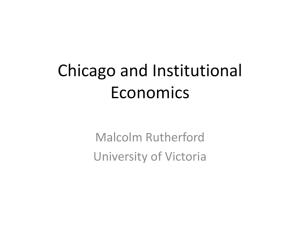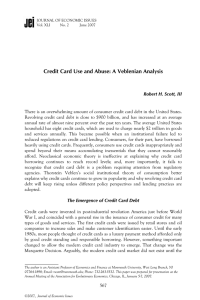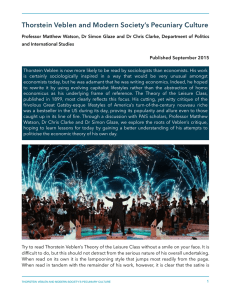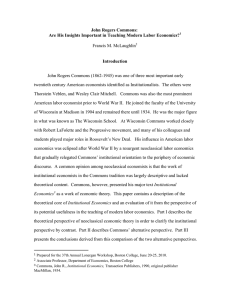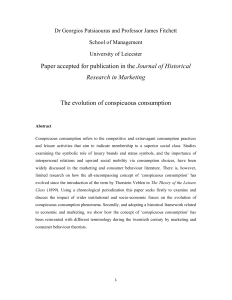History of economic thought
advertisement
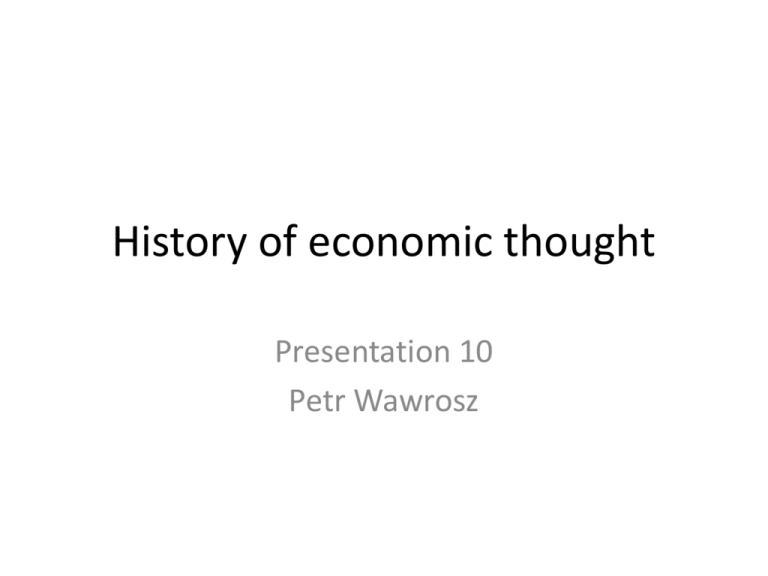
History of economic thought Presentation 10 Petr Wawrosz Old Institutional Economics (OIE) Basic characteristics • School of economic thought developed especially in the USA cca 1889 – 1945 • Regards institutions as the key elements of economics, their study is a major task for economists • Treats the economy as open envolving system, situated in nature, affected by technological change and embedden in broad set of political, cultural social and power relationships • Treats individuals not as fixed (utility maximisers) but shaped by their cultural and institutional situations. Institutions • Not very clear definition. • Walter Hamilton (1919): - adopts a broad definition of an institution, encompassing organizations as well as other social structures. - Hamilton associates an institution with ‘away of thought or action of some prevalence and permanence’. - institutions ‘impose form upon the activities of human beings’. He refers to institutions imposing ‘sanctions’ and ‘penalties’ and refers to ‘standards of conformity from which an individual may depart only at his peril’. - institutions often depend on, and interact with, one another. - not all institutions are the result of conscious design. He is fully aware that many institutions are ‘never created by design or cut to a blue print’. • John Commons (1931): institution as collective action in control, liberation and expansion of individual action. Collective action ranges all the way from unorganized custom to the many organized going concerns, such as the family, the corporation, the trade association, the trade union, the reserve system, the state. The principle common to all of them is greater or less control, liberation and expansion of individual action by collective action. Thorstein Veblen (1857 – 1929) • Is considered as the „father of institutional economics“. His idea influenced many scholars who forms old institutional economics. • A critic of the then economic theory. - it was based on an unrealistic view of man, which in turn led to misleading conclusion about the nature of economy as whole. The then theory saw man as a rational and calculating agent, solely concerned with a narrow conception of self-interest. - Veblen: human behavior is determined in large extent by instincts and habits. - Instincts and habits are formed by the social interaction between individuals and by the material basis of society, which is determined by the state of technology. - Continuous change. Theory of Leisured Class (1899) • Individual behavior is motivated mainly by the desire for social recognition and prestige. • Recognition may be also gained by adopting a prestigious pattern of consumption. • Conspicuous consumption: consumption of luxuries. -the more expensive a commodity is, the higher demand, demand can an increasing function of price, - markets are not able to allocate resources in efficient manner: conspicuous consumption leads to waste. The Theory of Business Enterprise • Veblen is deeply skeptical about modern business leadership. • The people who really understand the nature of production are the engineers and the production workers. The power is passed to shareholders and financial specialists who lost touch with basic production activities. „Absentee owners“. • Shareholders try to limit competition in order to achieve higher profit. • Principal-agent problem. Basic facts • Institutional economics focuses on understanding the role of the evolutionary process and the role of institutions in shaping economic behavior. Its original focus lay in Thorstein Veblen's instinct-oriented dichotomy between technology on the one side and the "ceremonial" sphere of society on the other. Its name and core elements trace back to a 1919 American Economic Review article by Walton H. Hamilton.[ • Institutional economics emphasizes a broader study of institutions and views markets as a result of the complex interaction of these various institutions (e.g. individuals, firms, states, social norms). John Commons (1869 – 1945) • Commons is best known for developing an analysis of collective action by the state and other institutions, which he saw as essential to understanding economics. • Commons believed that carefully crafted legislation could create social change; this view led him to be known as a socialist radical and instrumentalist. • His institutional theory was closely related to his remarkable successes in fact-finding and drafting legislation on a wide range of social issues for the state of Wisconsin. He drafted legislation establishing Wisconsin's worker's compensation program, the first of its kind in the United States. • His students, Edwin Witte and Arthur Altmeyer, went on to create the Social Security program in the 1930s. Wesley Mitchell (1874 – 1948) • Business Cycle (1913) . • This book offers an analytic description of the complicated processes by which seasons of business prosperity, crisis, depression, and revival come about in the modern world. The materials used consist chiefly of market reports and statistics concerning the business cycles which have run their course since 1890 in the United States, England, Germany and France. • Mitchell stated an endogenous theory, based on the internal dynamics of capitalism. Whereas neoclassical theories are deduced from unproven psychological axioms, he builds his theory from inductive generalities gained from empirical research. Clarence Edwin Ayres (1891 – 1972) • Publications: „The Nature of the Relationship Between Ethics and Economics“: first attempt to establish a philosophical base for institutionalism. • Ayres strove to identify universal moral values derived from a "technological continuum," defined as "the sum of human skills and tools." His system denounced mere statistical analyses, savings accumulation, and full employment as moral measures and recommended that governmental policy rather focus on "full production" or technological advance.







